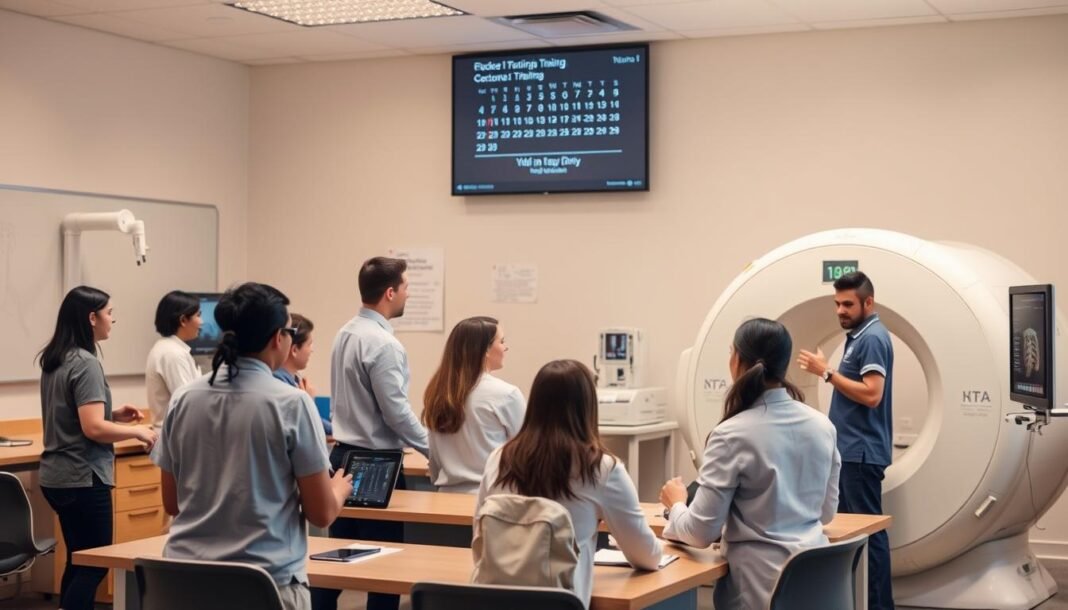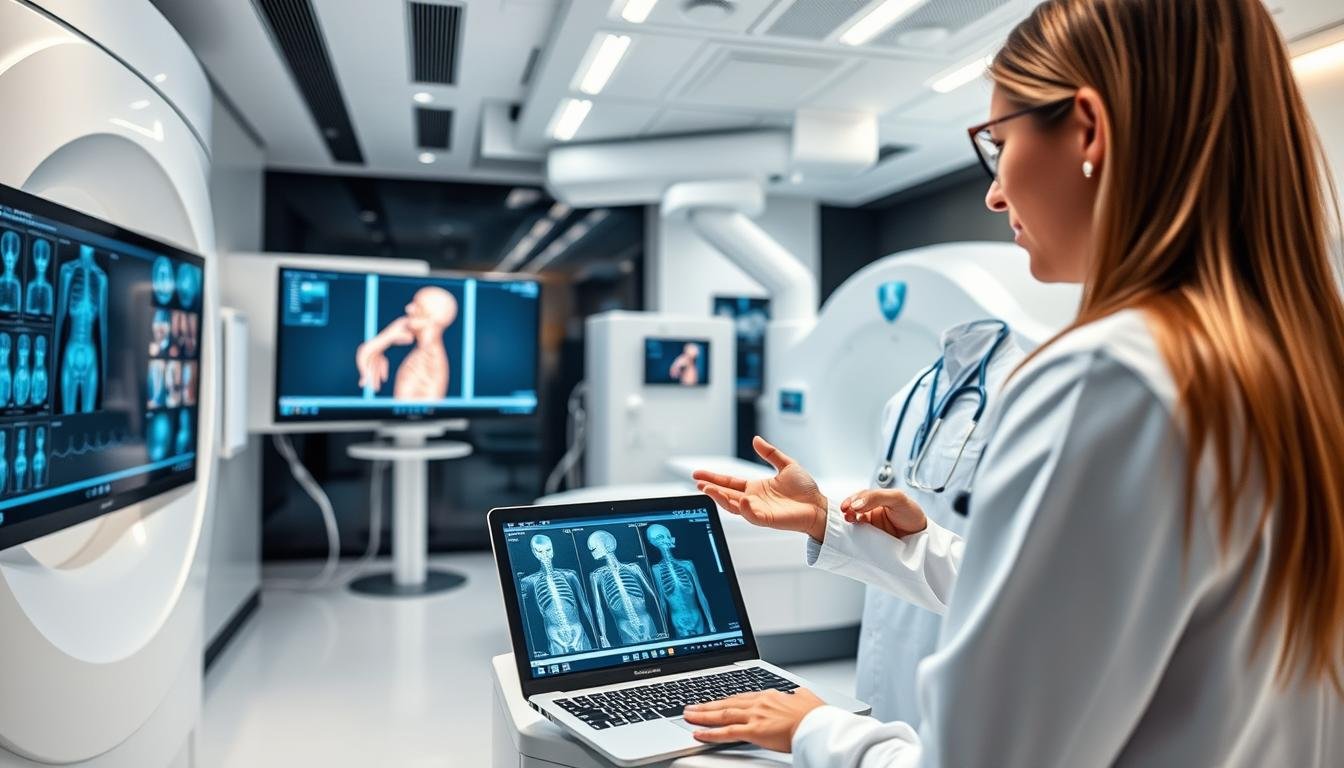Becoming a radiology technician is an exciting career choice. Understanding the educational requirements is the first step.
Program lengths for radiology tech schools can vary. It’s important to know the typical duration and the factors that affect it.
This guide explains the training needed to become a skilled technician, helping you make informed choices about your education.
A radiology classroom scene with students engaged in hands-on training, various medical imaging equipment like X-ray machines and MRI scanners, an instructor explaining concepts, a timeline or calendar displayed subtly in the background indicating the duration of the training, and warm lighting creating an educational atmosphere.
Introduction to Radiology Technology
Radiology technology is crucial in modern healthcare. It helps doctors see inside the body using various imaging methods.
These tools include X-rays, CT scans, MRIs, and PET scans. They help diagnose and track medical problems accurately.
Radiologic technologists are experts who run these imaging machines. They take high-quality pictures and keep patients safe during exams.
Medical imaging can find broken bones and tumors. It can also check how organs are working.
As this field grows, more skilled radiologic technologists will be needed. They play a key role in patient care and treatment.
Typical Length of Radiology Tech Programs
Radiology tech programs come in different types. Each has its length and requirements.
Associate degrees usually take about two years. They teach medical imaging, radiation safety, and patient care.
Bachelor’s degrees last 4 years. They cover advanced techniques and leadership skills.
Certificate programs are shorter, lasting 6 months to 2 years. They focus on essential skills for entry-level jobs.
The radiology tech school duration varies by program. The imaging program length depends on the school you choose.
Research your options carefully. Find a program that matches your goals and needs.
Factors Affecting Program Length
Radiology technology programs can take different amounts of time to complete. Full-time students usually graduate in 18 to 24 months, while part-time students may need 24 to 36 months.
Clinical experience is a big part of these programs. Students must complete 800 to 1,500 hours in healthcare settings.
The length of the program depends on the structure and curriculum. Some programs offer faster options or credit for past learning.
Each program has different requirements. It’s crucial to research programs before you start.
Curriculum Overview for Radiology Tech Programs
Radiology tech coursework covers theory and hands-on training. It blends science courses, specialized studies, and clinical rotations in healthcare settings.
Students start with human anatomy, physiology, and medical terminology courses. These build a strong foundation for understanding the human body.
Specialized classes cover radiographic techniques, radiation physics, and patient care. Students learn about medical imaging principles in depth.
Hands-on experience is crucial in radiology tech programs. Students work under experienced technicians in hospitals, clinics, and imaging centers.
They learn to operate X-ray, CT, and MRI machines. This practical training applies their knowledge to actual patient cases.
The curriculum prepares graduates for the national certification exam and prepares them for successful careers as radiology technicians.
Accreditation and Its Importance
Accreditation is vital for radiology technology education. It ensures high-quality training and impacts students’ career prospects.
Accredited programs follow strict imaging education standards. Recognized accrediting bodies set these standards.
JRCERT and ARRT are the leading accrediting organizations. They evaluate programs based on curriculum, faculty, resources, and student outcomes.
Choosing an accredited program is crucial. It guarantees education meets the industry’s highest standards.
Employers prefer graduates from accredited programs. These graduates are known for their expertise in medical imaging.
Many states require JRCERT-accredited program graduates for licensure. This makes accreditation key for a radiology tech’s career success.
Preparing for Radiology Tech School
Start getting ready for radiology tech school early. Learn about the program’s requirements and admission criteria.
Many schools require specific high school courses and a minimum GPA. Some may also require entrance exams or healthcare experience.
Understanding these can help you plan your high school classes. It can also guide your extracurricular activities.
Research different radiology tech programs in your area. Look at their curriculum and career options.
Talk to current students or alums. They can share insights about the program’s strengths and challenges.
Good preparation can boost your chances of getting into a top program. It’s the first step towards a rewarding medical imaging career.
Financial Considerations
Pursuing a career as a radiology technologist can be an excellent choice. However, it’s important to understand the financial aspects of this path.
Radiology tech school costs vary widely. Factors include program type, location, and whether it’s public or private.
Tuition for a radiology tech program can range from $10,000 to $20,000 yearly. Radiology tech school costs include textbooks, supplies, and fees.
Many financial aid options, such as scholarships, grants, and student loans, can help with your imaging education finances.
Some hospitals offer tuition reimbursement for employees in radiology tech training. This can significantly reduce your expenses.
Research your options and create a solid financial plan. This will help you achieve your medical imaging career goals.
Career Opportunities After Graduation
Radiology tech training opens doors to exciting career paths. Technologists use imaging equipment to help diagnose and treat medical conditions.
With a radiology tech degree, you can explore diverse job opportunities. These jobs cater to your interests and skills.
Many radiology tech graduates work in hospitals. They perform X-rays, CT scans, and MRI examinations.
This hands-on role involves working with patients and healthcare providers. Together, they deliver quality patient care.
Radiology technologists can also work in outpatient clinics and imaging centers. Some even work in mobile imaging units.
These settings offer specialized work environments. You can develop expertise in mammography, sonography, or radiation therapy.
Job prospects for radiology technicians are strong. The U.S. Bureau of Labor Statistics projects a 9% growth in imaging jobs.
This positive outlook makes radiology technology an appealing field. It offers a rewarding and in-demand healthcare career.
Post-Program Certification and Licensing
Radiology techs need certifications and licenses to work legally. They must pass exams like the ARRT to show their skills.
This opens doors to better jobs and career growth. Most states also require a license for imaging pros.
To get a license, techs must meet education and training rules. They may need to pass a state exam and keep learning.
These rules make sure techs work safely and ethically. Certification and licensing are key for imaging pros.
They prove a tech’s skills and protect patients. With these, techs can start great careers and give top-notch care.
Continuing Education for Radiology Technicians
Radiology techs need to keep up with new advances. This helps them give better care and stay job-ready.
Learning about exceptional imaging is key. Techs can get certified in CT, MRI, or mammography.
A modern radiology technician in a sleek, high-tech medical facility, surrounded by advanced imaging machines like CT and MRI scanners, engaged in a professional development training session with interactive screens displaying anatomy and radiology techniques, a bright and collaborative atmosphere.
Techs should learn about new rules and tech. They can do this through programs, meetings, and online classes.
Learning helps techs adapt to changes in healthcare. It lets them give the best care to patients.
Ongoing education shows dedication to the job. It helps techs grow and improves the whole field.
Conclusion: Your Path in Radiology
Becoming a radiology technician offers both challenges and opportunities. The journey includes a comprehensive curriculum and hands-on clinical training.
With dedication, you can turn your passion into a rewarding career. Choose an accredited institution that fits your goals.
The proper radiology tech career guidance and imaging education advice will help you succeed. You’ll master the technical skills and clinical expertise needed in this field.
Graduation is just the beginning of your radiology journey. Continuing education is crucial for long-term success in this industry.
Stay committed to learning and growing in radiology. You can make a real difference in patients’ lives.
FAQ
What is the typical length of radiology tech school programs?
Radiology tech programs vary in length. Associate’s degrees take 2 years, bachelor’s degrees 4 years, and certificates 6-24 months.
What factors can affect the length of a radiology tech program?
Program length depends on enrollment type and clinical requirements. Accreditation standards and prerequisite coursework also play a role.
What kind of curriculum is covered in radiology tech programs?
Programs mix classroom learning with hands-on training. They cover anatomy, imaging techniques, radiation safety, and patient care.
Why is program accreditation important for radiology tech education?
Accreditation ensures high-quality education and a standardized curriculum. It’s crucial for certification and licensing eligibility.
What are the typical prerequisites for getting into a radiology tech program?
Programs usually require a high school diploma and science coursework. Some need a minimum GPA and college-level prerequisite classes.
What are the financial considerations for attending radiology tech school?
Costs include tuition, fees, books, supplies, and clinical uniforms. Financial aid options are available to help students.
What career opportunities are available for radiology technicians after graduation?
Graduates can become radiologic, CT, or MRI technologists or work in mammography or radiation therapy.
What certifications and licenses are required for radiology technicians?
Graduates must obtain national certification through ARRT. Most states also require a state-issued license to practice.
How can radiology technicians continue their professional development?
Technicians can specialize in advanced imaging modalities. They can earn more certifications and attend conferences.
Continuing education courses help technicians stay up-to-date in their field.
you may also read:What Is a Med Tech: Healthcare Support Professional
















